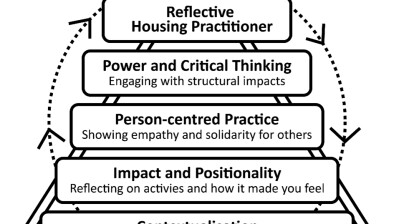Blog: Equal subsidy for equal scrutiny

Bruce Forbes, director of Angus Housing Association, writes on the cost of new council houses in Angus.
On 6th June, Angus Council’s Communities Committee gave the go-ahead to a project to build four houses in Arbroath at an estimated cost of around £1 million. Even for someone with as poor arithmetical skills as myself, it’s easy to work that out at a quarter of a million pounds being spent on each new home.
What is harder for me to work out, after 40 years of working in the housing sector, is: “Why are these houses costing so much?” Even more perplexing is why the Officers running Angus Council aren’t being rigorously questioned by their political masters when they claim that these astronomically high building costs are value for public money?
Perhaps, naively, when I read about these costs in the local press, I was truly shocked and wrote to the Housing Minister, Kevin Stewart MSP, suggesting that a way of making better use of public money and delivering the Scottish Government’s 50,000 house target would be to increase the subsidies given to Councils to build new houses to the same level as those received by Housing Associations. In return, I have suggested, Councils should be subject to the same cost benchmarks as Housing Associations and the same scrutiny and approval regime. This would, in the long term, make better use of, and deliver better outcomes for each pound of subsidy the Government puts in. More importantly, it wouldn’t add £200,000 of borrowing to the Housing Revenue Account for each house built – effectively a mortgage that has to be paid back through rent pooling by increasing the rents of the Council Tenants who are not actually enjoying the benefits of a home which cost a quarter of a million quid to build.
My letter is now with the Minister. Based on my past experiences with the Scottish Government, when trying to engender some light rather than heat in to the debate over getting value for money, I remain confident of a mature, measured and constructive response in due course.
Unfortunately, I cannot say the same for the response to date from Angus Council. In the coverage of this issue by The Herald’s social affairs correspondent, Stephen Naysmith, on June 26th, the Council’s “spokesman” not only defended the costs but also felt the need to try to indirectly traduce the work of their Housing Associations partners by concluding his remarks with the following statement,
“Owing to the long term successful management of the Council’s Housing Revenue Account and a superb relationship with our tenants, we are in a fortunate position in not having to be in a race to the bottom in terms of cutting construction costs at the expense of quality.” (My italics). In 30 years of building new Housing Association homes, this is the first suggestion I have ever heard that the quality of what we build is in some way deficient in quality. I know for certain that this isn’t the view of our tenants.
Strangely, in these days of austerity, there is no mention whatsoever of support for an idea that would increase public subsidy to the Council’s Housing Revenue Account and help keep their rents affordable - presumably something their tenants might welcome.
This, of course, brings us back to the fundamentals. Just how much can we, as a nation , afford to pay to build housing for rent ? – housing whose rent, for some of our poorest citizens, has to be paid for through the public subsidy of Housing Benefit. The system we have in place must be seen to be value for money if it is to continue to have the full support of wider society. Why? Very simply, the majority of Scots are now owners, not tenants, struggling to pay a mortgage because they continue to be sold the myth that home ownership is the tenure of aspiration.
So, let’s put my call for value for money in to some perspective. Some publicly-available figures to consider which make very interesting reading;
Trying to explain a disparity in costs of almost £100,000 per house by saying the site had to be cleared or that a sprinkler system which might, let’s say generously, cost around £4,000 per unit, just doesn’t cut it.
As an alternative, a developer who partners with us regularly to build excellent houses for Angus Housing Association, meeting all Scottish Government quality standards, is currently marketing a site in Friockheim for sale. Instead of building new houses at £232,000 each, the Council could simply have bought them off the shelf. At Friockheim Green (google it and check them out), they could have got a 2 bedroomed semi-detached bungalow for £155,000 or even a 3 bedroomed semi-detached villa for £175,000 or how about a 101 square metre 3 bedroomed detached bungalow at £195,000. These prices, of course, allow for the developer’s profit margin.
More importantly, they could have gotten four new homes for what it cost them to build three and one less family would be homeless or languishing on a waiting list.
This isn’t about Angus Council or Angus Housing Association – these are just examples of the housing market that I know best.
The key issue is abut efficiency and value for money. The affordable rented houses being built now are of a very high standard in both the Council and Housing Association sectors. We do, however, all have a responsibility to build as many of them as possible with the resources made available to us and I want to generate a sensible and mature debate about how we can achieve this.
Bruce Forbes
Director
Angus Housing Association









